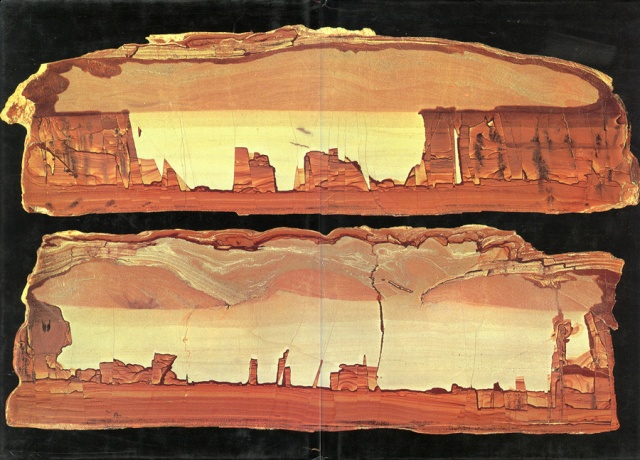The Iron Ring, an Art Project by Cecilia Jonsson (2014)
Filed under brochure | Tags: · art, environment, installation art, metallurgy, mineralogy, mining, plants
While “green mining” aims for a more ecological approach to mining metals, The Iron Ring explores how contaminated mining grounds may benefit from the mining of metals. For this work, 24kg of iron-tainted grass was removed from contaminated mining grounds and transformed into a ring of 2g metallic iron.
The project elaborates on the possibilities to utilize the cleansing process of the naturalized, wild growing grass: Imperata cylindrica. An invasive vile weed, which overlooked tolerance and ability to hyper accumulate iron inside its roots, stems and leaves are left unutilized. The Iron Ring proposes to harvest the grass for the purpose of extracting the ore that is inside them. The result is a scenario for iron mining that, instead of furthering destruction, could actually contribute to the environmental rehabilitation of abandoned metal mines.
The Iron Ring came about through trials and failures, in a process of close collaboration with smiths, scientists, technicians and farmers met along the way.
This e-book consists of two parts. The first is a visual essay by Cecilia Jonsson that reports on the seven chronological steps that were required to create an iron ring out of 24kg of grass harvested from the acidic river banks of a landscape in Spain severely transformed by opencast mining. In the second part, professor James Jackson Griffith, who participated in Jonsson’s preliminary research on mining restoration in Brazil, discusses The Iron Ring from an environmental-philosophical perspective.
Publisher V2_, Rotterdam, 2014
Open Access
PDF (4 MB, EPUB)
Comment (0)Roger Caillois: The Writing of Stones (1970/1985)
Filed under book | Tags: · calligraphy, geology, mineralogy, writing

“The Writing of Stones is a fascinating meditation on the human imagination contemplating the interior of stones. Caillois examines patterns that are revealed by polishing sections of minerals such as agate, jasper, and onyx. He considers the impact these configurations have had upon the human imagination throughout history and he reviews man’s attempt to categorize and explain them.
Marguerite Yourcenar [in her introduction] points out that ‘there had taken place in [his] intellect the equivalent of the Copernican revolution: man was no longer the center of the universe, except in the sense that the center is everywhere; man, like all the rest, was a cog in the whole system of turning wheels. Quite early on, having entered ‘the forbidden laboratories,’ Caillois applied himself to the study of diagonals which link the species, of the recurrent phenomena that act, so to speak as a matrix of forms.’ Caillois found the presence throughout the universe of a sensibility and a consciousness analogous to our own. One way which this consciousness expresses itself is in a “natural fantasy” that is evident in the pictures found in stones. Man’s own aesthetic may then be no more than one of many manifestations of an all-pervasive aesthetic that reveals itself in the natural world.”
First published as L’ecriture des pierres, Editions d’Art Albert Skira, Genève, 1970
Translated by Barbara Bray
With an Introduction by Marguerite Yourcenar
Publisher University Press of Virginia, Charlotesville, 1985
ISBN 0813910501, 9780813910505
108 pages
via pink panter
Commentaries: Marina Warner (Cabinet), 50 Watts.
Interview with author (video, 26 min, 1974, ina.fr, in French, via Véfa Lucas)
PDF (5 MB, updated on 2020-11-19)
Comments (5)
